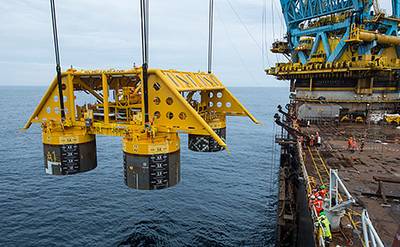Statoil, DNV GL Drive Subsea Factory Interface Standardization
Statoil has entered into an agreement with DNV GL to establish an industrial cooperation to introduce an international industry standard for subsea process technology.
DNV GL will lead a joint industry project (JIP) with important subsea operators to find industrial standards which will make it more profitable to develop larger projects with subsea processing technology.
Today, subsea developments are characterized by tailor-made solutions. Subsea pumps have been used in many oil fields, and the first subsea compression systems will be installed in 2014 to increase gas production from the Åsgard and Gullfaks fields.
By standardizing tie-in technology and module sizes it will be easier to combine different types of technology and modules to adapt developments to project needs.
“Think of the modules as LEGO bricks. By having standardized module dimensions which may be assembled by means of standard tie-ins, we may combine technology from different suppliers, and also cover several needs through subsea solutions. This will reduce costs and increase volume,” said executive vice president in Technology, Projects & Drilling in Statoil (STO), Margareth Øvrum.
The cooperation project should be set up by the end of the first quarter in 2015. The standards to be established should be so-called open standards, meaning that this is technology which all suppliers may use, without special rights.
"The industry needs to lower costs to enable more subsea developments and increase the use of subsea processing technology," Øvrum said. During the last 10-12 years, costs related to subsea developments have increased by 250%.
Standardization is one of the improvement measures to reduce costs and increase efficiency in operations which Statoil presented as part of its capital markets day in February this year. Øvrum emphasizes that this standardization will not take place at the cost of new and important technology development.
"It is important not only for Statoil, but for the industry in general, that competition is maintained in the development of the process technology itself, and the input which is made to the modules. By standardizing the tie-ins and the module sizes, it will be possible to make use of the best technology for each individual function, independent of supplier," she said.
"This will lead to more subsea projects being realised, benefitting both operators and suppliers. We will achieve increased recovery as more projects will be profitable to develop. Standard solutions will be easier and safer to handle, which will also reduce maintenance costs," Øvrum said.
Earlier this year, Statoil awarded contracts for feasibility studies related to the implementation of subsea processing factories.
The following three contracts were awarded:
- FMC – Oil boosting case
- Saipem – Åsgard subsea pre-compression case
- Kongsberg – SoW in control systems
statoil.com
dnvgl.com












